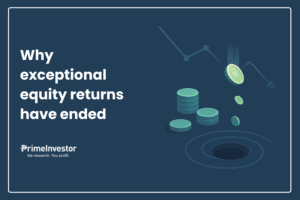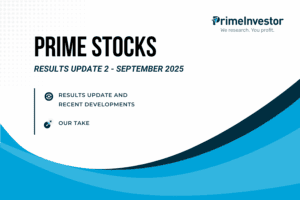The 8.2% correction in Nifty 50 TRI (9.9% in Nifty 100 TRI) appears modest compared to the steeper 15-19% decline in mid and small caps. However, this correction has effectively brought large cap stocks to more reasonable valuations.

Nifty 50’s P/E ratio now stands at a moderate 20.3x, down from its September 2024 peak of 24.3 times, and below the 2022-24 average of 22 times. This moderation stems primarily from two heavyweight sectors:
- Banking and Finance: Nifty Bank’s price-to-book ratio dropped from 3 times in June 2024 to 2.1 times currently, pressured by lower capex and tighter RBI regulations.
- IT: Nifty IT’s P/E ratio fell from 36 times in December 2024 to 24.7 times, impacted by US slowdown concerns following Trump tariffs.
While the IT sector awaits clarity (March quarter earnings will provide direction, with TCS showing promising order flows to begin with), the banking sector demonstrated strong Q3 earnings and stands to benefit from easing lending regulations. The correction in these heavyweights plus the oil and gas space (another sector to receive high index weight) provides reasonable entry opportunity into the large cap segment.
You can play this either exclusively through passive funds or add active funds that beat the index. Nippon India Large Cap, which is part of the Prime Funds list, is one such outperforming large-cap fund.
The fund
Nippon India Large Cap (Nippon Large Cap), earlier called Reliance Top 200 fund, is among the older schemes with a close to 18-year track record. It changed hands from Reliance to Nippon and also underwent name change when SEBI came up with new categories. This fund is not a new recommendation by us and is already part of Prime Funds.
For those looking for a large cap opportunity to enter the market now, this fund can serve well – even if you hold the Nifty 50 or Nifty 100 index funds.
As a large cap, the fund may not have much leeway to go outside the top 100 stocks (large caps should account for at least 80%) – but what it can do is play with the stock and sector weights to make returns in its favour. For example, while its benchmark BSE 100 TRI had 15% in technology as of March 2025, Nippon Large Cap had just 9.3%. The fund chose to be marginally overweight or energy and consumer discretionary. This exemplifies how an active fund can strategically construct its portfolio within regulatory parameters to potentially enhance returns.
Performance
Nippon India Large Cap faced challenges in 2019-20 but has since rebounded to become one of the most consistent performers in the large-cap fund category. In rolling 1-year returns analysed over a 3-year return period, the fund outperformed its benchmark BSE 100 TRI 98% of the time and achieved a perfect 100% outperformance against the Nifty 100 TRI (we prefer to use Nifty 100 TRI as the standard comparison benchmark for all large-cap funds for consistency). The fund also outperformed its category peers 98% of the time during this rolling 1-year period.
When examining rolling 3-year returns over a 5-year timeframe (with returns rolling daily and the firs return period starting from April 2020), Nippon India Large Cap beat the Nifty 100 TRI 87% of the time. Though its 2019-20 underperformance affected its 3-year performance metrics, the fund is now working to fully recover from this setback.
For context, the large-cap fund category as a whole outperformed the Nifty 100 TRI only 43% of the time during the same 3-year rolling return analysis period. Active large-cap funds have historically struggled to beat their benchmarks; even with recent improvement, the category average outperformance is just 54% over rolling 3-year periods. This highlights how challenging it remains for active large-cap funds to consistently outperform indexes.
Nippon India Large Cap has distinguished itself with its average rolling 1-year returns exceeding the Nifty 100 TRI by 8 percentage points. For longer investment horizons, while less dramatic, the fund’s average 3-year returns still surpass the index by 2 percentage points.
The fund also scores among the best in terms of least downside (falls during down markets) and fits low-volatility requirement.
Portfolio
Looking at portfolio overlap in large-cap funds may not provide much clue unless one looks at individual stock weights. Nippon Large Cap sports a 60% overlap with the Nifty 100 index but as discussed earlier, its sector weights, and therefore stock weights vary. Infosys, for example is presently not in its top 5 holdings while the large-cap indices would have the IT giant in their top holdings.
The fund’s performance trajectory has seen fluctuations, but its recent recovery following the 2019-20 underperformance has been particularly impressive. This turnaround was largely driven by prescient investments in PSU banks and engineering/manufacturing companies that were out of favour at the time but eventually delivered substantial returns.
Over the past year, Nippon Large Cap has strategically increased its exposure to energy, banking and finance, non-FMCG consumption, and engineering sectors, while reducing its positions in IT and slightly decreasing pharmaceutical holdings. Though this allocation might face short-term challenges as markets could favour previously underperforming sectors like IT first, the fund’s overweight position in the finance sector may help offset any temporary disadvantages.
Adding stability to the fund’s strategy is the continuity in management, with Sailesh Raj Bahn serving as fund manager since inception.
Suitability
The fund is suitable for any equity investor’s long-term portfolio. Investment, if made in lumpsum now, should be followed up with SIPs. If you already own other large caps or too many flexi caps, you can skip this. You can add this fund for diversification, even if you hold a passive large-cap fund, provided you wish to invest in an active fund.




10 thoughts on “Prime Fund Recommendation: A large-cap fund to weather volatility”
Seems that Motilal Oswal Largcap Fund has delivered outstanding returns and not surprisingly their midcap fund also delivered stellar returns. This probably is the case because the fund managers are same for both the funds and what is actually surprising is that the fund house did not have a largecap fund as a fund house until Feb 2024 when they launched their largecap fund. This largcap fund obviously cannot make it to Prime Funds or Ratings because of lack of sufficient history. It does seem that one can bet on this largecap fund given the returns generated by the management team in case of midcap fund. What say? Thanks!!
You have said all there is to say 🙂
While it is true that Nippon Large cap is one of the best large cap funds, I find it very interesting that ICICI Equity & Debt fund has given equally good returns most of the times and even better returns at times (even 5 year rolling returns) despite being a aggressive hybrid fund. In fact it has done better than ICICI’s own Blue chip fund!
It is true. Two things can work in their favour (or impact them) – one they can go anywhere in terms of market cap segments. Two, they can go anywhere with debt, play duration and get returns. So that definitely helps. And after any correction, hybrids will look better – improving their short nad medium record.
Multi Cap Fund vs. Flexi Cap Fund – which is better for the long term? Which one has a higher probability of outperforming over time: the Multi Cap Fund or the Flexi Cap Fund?
Multi caps carry higher risk given their mid and small cap exposure. SO their risk-return (or loss) potential would be higher. Vidya
Hi Vidya,
PPFAS also is favouring financials from some time. Isn’t that better, being a flexi cap fund. It’s AUM is high, so is Nippon large cap?
Thanks
Rajiv
Given one fund call does not negate the other recommendations 🙂 We have mentioned that if you already hold flexicaps, you need not add this. Vidya
Can we get more recommendations on Multi asset funds especially for downward protection during market cycles from PI team?
Thanks,Praveen
You can pick multi asset funds from Prime Funds or from our buy/hold/sell calls. We have identified an equity opportunity to buy on fall and earlier given a debt opportunity for the rate scenario. Thanks, Vidya
Comments are closed.